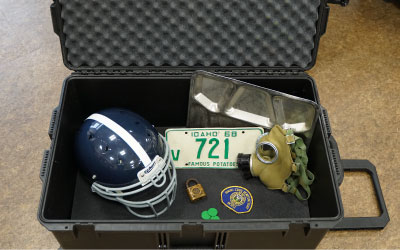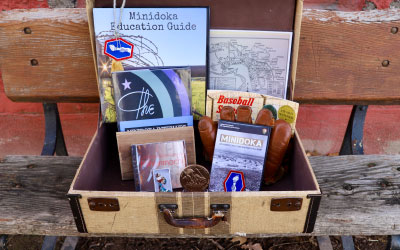
Traveling Trunks
Bring the Idaho State Museum to You!
We are creating engaging, multidisciplinary outreach programs for Idaho schools and community groups.
Trunks are available for a 2-week check-out period.
Thanks to the generosity of the Minidoka National Historic Site, the Laura Moore Cunningham Foundation, and the Governor’s Lewis and Clark Trail Committee, traveling trunks are currently offered free of charge to Idaho teachers.
Contact
(208) 334-2120

Lewis & Clark
Grades 3-5
This trunk provides exciting artifacts for students to examine and learn about the trials and tribulations experienced by the Corps of Discovery as they journeyed across North America.
1 Powder Horn
1 Fishing Kit
1 Plant Press
1 Piece of Slate with Chalk
1 Betty Lamp
1 Refracting Telescope
1 Thermometer
1 Sundial Compass
10 Packages of Powdered Ink
35 Quill Pens
1 To-go Writing Kit
1 Brass Balance and Weights Set
1 Pipe Tomahawk
1 Peace Medal
1 Pouch of Trade Beads
1 Bullet Mold
1 Pouch of Lead Bullets
1 Flint and Steel Set
2 Beeswax Candles
1 Tin Cup
1 Curriculum Binder
1 Flash Drive with Curriculum Content
1 Object Handling Guidelines Poster
Handouts
Lesson Plans & Activities
Artifacts are tangible connections to the past; with careful examination they can reveal how people lived. In this lesson, students will analyze reproductions of artifacts from the Corps of Discovery military expedition led by Lewis and Clark. Members of the Corps used a variety of tools, resources, weapons, and trade goods throughout the expedition. In this lesson, students will examine the objects in the trunk and hypothesize about their use. They will use the primary and secondary sources provided to learn more about the object.
The Corps of Discovery encountered many Native American nations during their expedition. These nations spoke a variety of languages, which many members of the expedition did not know. The knowledge of the translators hired by Lewis and Clark were invaluable to the overall success of the expedition. In this lesson, students will use reproductions of artifacts used by the Corps of Discovery to learn about the experiences the members of the expedition faced when interacting with Native American nations. They will learn about the importance of language and translators on the Corps of Discovery expedition. This lesson is best done after completing the Investigating Artifacts lesson.
Archaeologists can learn about the past by copying how people made or used objects; this is called experimental archaeology. In this lesson, students will use objects from the trunk to learn more about the objects and their use. Members of the Corps of Discovery utilized a variety of tools, resources, weapons, and trade goods throughout the expedition. While using the objects, students will consider the parts, purpose, and creativity of the objects. This lesson is best when done after completing the Artifact Investigations lesson.
Lewis and Clark took detailed notes of plants and animals in their journals during the Corps of Discovery expedition. No artist traveled with the Corps of Discovery to draw the animals, plants, or scenic landscapes the Corps encountered, but Lewis and Clark sometimes drew pictures in their journals. Lewis and Clark’s descriptions were also used by artists to draw the specimen the expedition collected. Some of the animals and plants were previously unknown to Euro-Americans. In this activity, students will act like an artist who is listening to Lewis and Clark’s description, and draw their own picture of the specimen!
A compass helped Lewis and Clark find their way because it always points north. In this activity, students will learn more about this tool and create their own to use on their adventures!
Lewis and Clark kept journals about their experiences throughout the Corps of Discovery expedition, writing about the weather, animals, geography, food, and people they encountered. Without ink and quill pens, Lewis and Clark would have been unable to journal about their experiences. In this activity, students will write with ink and a quill pen to describe their surroundings like members of the Corps of Discovery.

Old Idaho Penitentiary
Grades 6-12
Discover the stories and circumstances behind the major riots and disturbances at the Old Idaho State Penitentiary through artwork, artifacts, stories, and more. Students will be challenged with thought-provoking questions that will ask them to consider how these events shaped the current state of corrections in Idaho.
1 Football Helmet
1 Yale Lock
1 Metal Lunch Tray
1 Idaho License Plate
1 Idaho State Prison Guard Patch
5 Counterfeit Commissary Coins
1 Gas Mask
1 The Idaho Statesman article from 1971
1 The Idaho Statesman article from 1973
10 Measuring Tapes
1 Curriculum Binder
1 Flash Drive with Curriculum Content
1 Flash Drive with Old Idaho Penitentiary Virtual Tour Videos
1 Object Handling Guidelines Poster
Handouts
Lesson Plans & Activities
Artifacts are tangible links to the past; with careful examination they can reveal how people lived. In this lesson, students will analyze artifacts and reproductions from the Old Idaho State Penitentiary to better understand the life of its former inhabitants and the riots that occurred. During its 101 years in use, the Idaho State Penitentiary saw thousands of incarcerated individuals pass through its doors and seven significant disturbances and riots occur within its walls. In this lesson, students will examine the objects to learn about their use at the Old Idaho State Penitentiary. Students will also use primary and secondary sources to contextualize the objects into the history of riots at the prison.
Over the course of the 101 years the Idaho State Penitentiary operated, a total of seven riots and disturbances occurred. Incarcerated people rioted for a number of reasons, including poor food quality, lack of proper medical care, and high commissary prices. In this lesson, students will be placed in the middle of the 1952 riot, when the warden gives the incarcerated people a choice to either disperse or face consequences if the riot continues. Some students will play real people in the event, advocating for their side during a discussion that occurs when the warden gave the imprisoned people 10 minutes to disperse and end the riot. Students will be asked if in the 1952 riot, was justice disturbed or justice disturbing. This lesson is best done after the Artifact Investigations Lesson.
How were incarcerated people identified before fingerprinting or DNA testing? The Bertillon method was used at the Idaho State Penitentiary to identify individuals until fingerprinting proved to be more accurate and useful. In this activity, students will experience what incarcerated people did when they first arrived at the institution by completing the Bertillon system measurements with a group.
Lewis and Clark took detailed notes of plants and animals in their journals during the Corps of Discovery expedition. No artist traveled with the Corps of Discovery to draw the animals, plants, or scenic landscapes the Corps encountered, but Lewis and Clark sometimes drew pictures in their journals. Lewis and Clark’s descriptions were also used by artists to draw the specimen the expedition collected. Some of the animals and plants were previously unknown to Euro-Americans. In this activity, students will act like an artist who is listening to Lewis and Clark’s description, and draw their own picture of the specimen!
A compass helped Lewis and Clark find their way because it always points north. In this activity, students will learn more about this tool and create their own to use on their adventures!
How can art make history and stories accessible to more people? The Disturbing Justice exhibit tells the story of the seven riots and uprisings at the Idaho State Penitentiary through comic book art. By exhibiting the riots and uprisings through visual storytelling, the Old Idaho Penitentiary was able to cater to different learning and communication styles. Artist Allen Gladfelter illustrated the Disturbing Justice exhibit for the Old Idaho Penitentiary, using his past experience in creating comic books to complete the project. In this activity, students will create their own comic book art panels to share the story of a riot or uprising from the Old Pen’s history.

Minidoka Incarceration Camp
Grades 3-12
This trunk provides artifacts, books, music, and other materials for teachers to introduce students to the history of thousands of Japanese American individuals and their illegal incarceration during WWII.
1 Congressional Gold Medal: Nisei Soldiers of WWII (replica)
1 Baseball Glove (replica)
1 Plank of wood from Minidoka Post Office
1 442nd Regimental Combat Team patch (replica)
1 Minidoka Swing Band CD
1 Hand carved bird pin (replica)
1 War Relocation Authority family number tag (replica)
1 Map of Minidoka
1 DVD and website link to the Minidoka Park Film Minidoka: An American Concentration Camp (YouTube) (length 30:01)
1 Copy of The Minidoka Interlude (reprint)
1 Curriculum Binder
1 Copy of Baseball Saved Us
1 Copy of A Place Where Sunflowers Grow
1 Flash Drive with Curriculum Content
1 Object Handling Guidelines Poster
Handouts
Lesson Plans & Activities
Artifacts are tangible links to the past; with careful examination they can reveal how people lived. In this lesson, students will analyze authentic artifacts and reproductions from the Minidoka Relocation Center to better comprehend Japanese American experiences during World War II. The objects include a plank of wood from the post office at Minidoka, a replica of a War Relocation Authority family number tag that was issued to an incarceree; an insignia patch of the 442nd Regimental Combat Team; the Nisei Soldiers of WWII Congressional Gold Medal; a baseball glove similar to gloves used in the 1940s; a carved wooden bird pin; The Minidoka Interlude, a book which offers an insight into camp life; and a swing band CD feature songs from the WWII era.

Hispanic Heritage
Grades 3-5
The trunk was created with community partners and historians and includes lesson plans and activities that align with state standards for grades 3-5. The lesson plans and activities in the trunk are also translated into Spanish. Use the trunk to learn about vaqueros, ballet folklorico, corridos, Dia de los Muertos, and more!
1 Trumpet
1 Pair of Cowboy Boots
2 Plastic Ears of Corn
1 Fire Helmet
1 Dance Skirt
1 Rawhide Strip
1 Braided Rawhide Rope
1 Pair of Spurs
3 Pesos
3 Packs of Seeds (corn, squash, beans)
105 Suede Strips
1 Curriculum Binder
1 Flash Drive with Curriculum Content
1 Object Handling Guidelines Poster
1 Copy of Where Are You From?
1 Copy of Pepe and the Parade: A Celebration of Hispanic Heritage
1 Copy of Rosita y Conchita
1 Copy of Jesús Urquides: Idaho’s Premier Muleteer
1 Copy of Esperanza Rising
1 Copy of Danza!
1 Copy of Latinos in Idaho: Celebrando Cultura
1 Copy of Voces Hispanas: Hispanic Voices of Idaho
1 Copy of A Kid’s Guide to Latino History
1 Copy of Nuestros Corridos: Latinos in Idaho
1 Copy of Los Colores de México Folklórico Edition
Lesson Plans & Activities
Artifacts are tangible links to the past; with careful examination they can reveal how people lived. In this lesson, students will analyze reproductions related to Hispanic heritage in Idaho. Students will examine the objects in the trunk and hypothesize about their use and larger connection to people’s experiences in Idaho. Students will also use the primary and secondary sources provided to learn more about the object.
Cowboys are popular figures of the West, easily identified by their hats, rope skills, and lingo. American cowboy culture was influenced by many things, including vaqueros from Mexico and the Southwestern United States. In this lesson, students will learn more about vaquero objects and influence on the Western United States and cowboy culture through equipment, animal handling, and language. Students will also learn knots and braids on “rawhide” strips. This lesson plan is best done after the Artifact Investigations lesson plan.
In many Hispanic cultures, dancing plays an important role in expression, tradition, and heritage. In Mexico, baile folklorico, or folkloric dance, is the performance of traditional cultural dances. Each region in Mexico is known for unique local dances, there is not one single style of ballet folklorico. Ballet folklorico is the art of traditional Mexican dances that incorporate ballet postures and positions such as pointed toes and exaggerated movements. In this activity, students will read a book about El Ballet Folklorico de Mexico, learn about the history of ballet folklorico, the different costumes from each Mexican state, and learn a short dance led by Monique N. Michel, the director of Ballet Folklorico Mexico Lindo!
Día de los Muertos is a holiday that remembers loved ones who passed away. Día de los Muertos is celebrated by creating altars to honor the dead. People place offerings, or ofrendas, on the altar. These offerings are items the person liked, such as food or favorite objects.
In this activity, students will learn about important Hispanic figures in Idaho history, and create ofrendas for those people to honor their lives.
A corrido is a Mexican musical form. A corrido “has its roots in oral tradition and it is a type of ballad using simple and ordinary speech that tells a real and profound story.” In 2010, Ana María Nevárez-Schachtell worked with groups of musicians to write and perform corridos about Hispanic people and their impact in Idaho’s history. Ana María later published and recorded the corridos written for the project in Nuestros Corridos: Latinos in Idaho History, Idaho Latino History through Song and Word 1863-2013. There is a copy of this book in the trunk, which includes two CDs. In this activity, students will listen to some of the corridos on the CDs, identify history facts in the corrido, identify parts of a corrido, and write a verse of their own corrido.
Indigenous farmers in Mesoamerica tended to milpas. Milpa comes from the Indigenous Nahuatl phrase mil-pa, which translates to “cultivated field.” Crops grown in this system include corn, beans, squash, as well as other plants. This holistic growing method began in Mexico before European contact. Trade routes brought the method of planting corn, beans, and squash together further north, where the Iroquois named it the “Three Sisters.” Native people throughout the Americas used this planting method.
When planted together, corn, beans, and squash create a sustainable agricultural ecosystem. Beans put nitrogen into the soil, which plants need to grow. Corn stalks give beans a place to climb. Squash spreads out on the ground, preventing weeds from growing and keeping the soil moist. In this activity, students will learn about the Three Sisters crops, why they are planted together, and get an opportunity to plant their own Three Sisters Garden.

